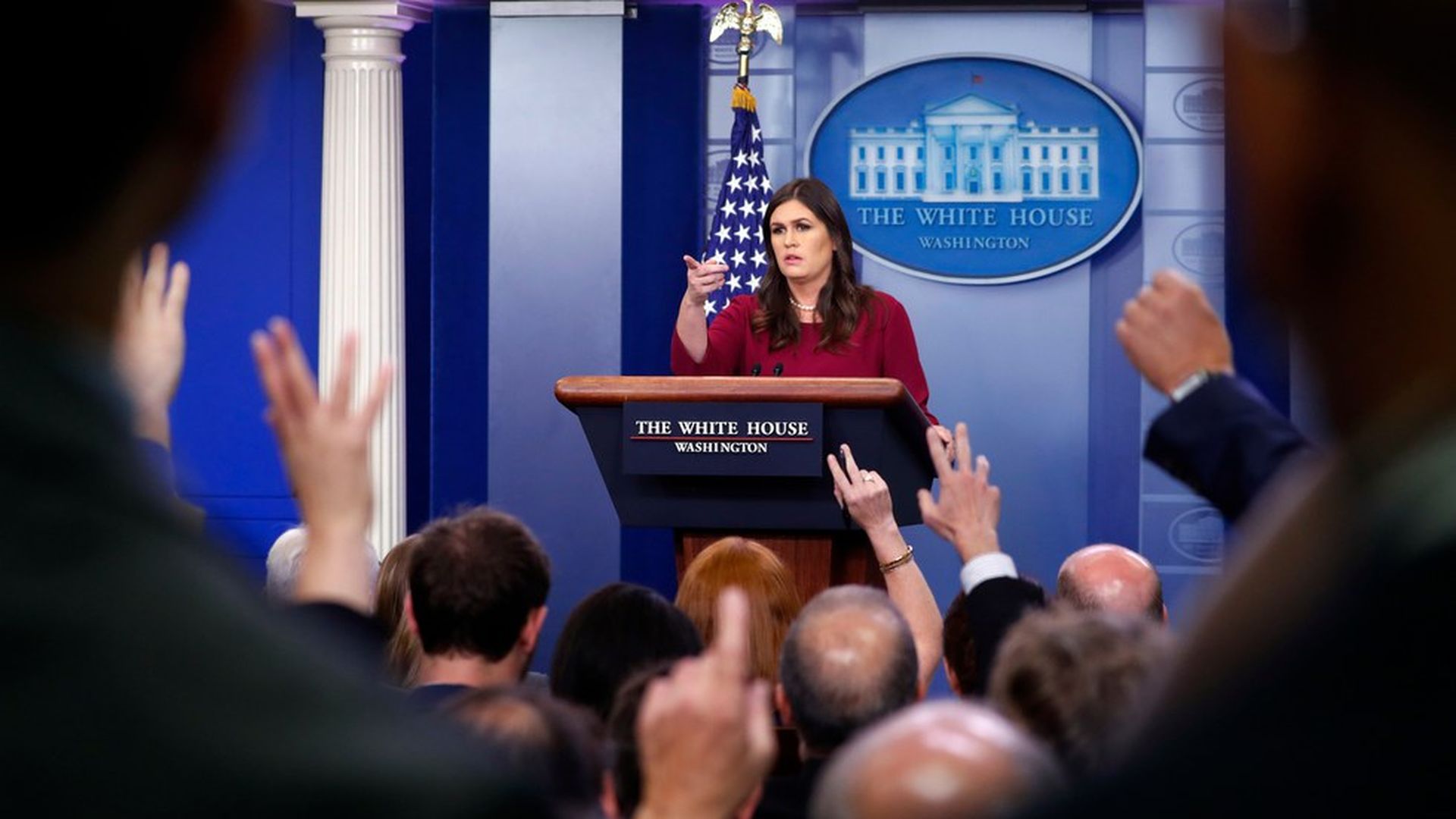Legal Obstacles Hamper Trump's Immigration Crackdown

Table of Contents
Challenges to Executive Orders
Trump's administration relied heavily on executive orders to implement its immigration agenda. However, these orders faced numerous legal challenges, ultimately limiting their effectiveness.
The Travel Ban
The Trump administration's travel ban, initially targeting several Muslim-majority countries, ignited immediate and widespread legal challenges. The core arguments centered on whether the ban violated the Establishment Clause of the First Amendment, prohibiting government endorsement of religion, and whether it exceeded the president's authority under existing immigration laws.
- Supreme Court Cases: The Supreme Court heard two cases related to the travel ban, ultimately upholding a revised version in Trump v. Hawaii (2018). The Court's decision highlighted the narrow scope of judicial review when it comes to national security concerns.
- Lower Court Rulings: Before reaching the Supreme Court, lower courts issued conflicting rulings, temporarily blocking or modifying parts of the ban, demonstrating the significant legal uncertainty surrounding the executive order.
- Arguments Presented: Supporters argued the ban was necessary for national security, citing terrorism concerns. Opponents argued it was discriminatory, targeting specific religious groups and violating constitutional rights.
- Impact: The travel ban significantly impacted individuals from designated countries, delaying or preventing travel to the United States and creating widespread disruption.
DACA and Deferred Action
The Deferred Action for Childhood Arrivals (DACA) program, implemented by the Obama administration, provided temporary protection from deportation for undocumented immigrants brought to the US as children (Dreamers). Trump's administration attempted to end DACA, sparking major legal battles.
- Legal Basis of DACA: The legal basis of DACA was consistently challenged, with opponents arguing it exceeded the executive branch's authority.
- Challenges from States: Several states filed lawsuits against the Obama administration, and later against the Trump administration, aiming to end DACA.
- Supreme Court Ruling: The Supreme Court ruled against the Trump administration's attempt to terminate DACA in Department of Homeland Security v. Regents of the University of California (2020), citing procedural flaws in the rescission process.
- Political Implications: The DACA debate became highly politicized, highlighting the deep divisions within the US regarding immigration policy and the rights of undocumented immigrants.
- Future of DACA Recipients: The future of DACA remains uncertain, with the program's legal status continuing to be subject to legal and political challenges.
Obstacles to Border Security Initiatives
The Trump administration's efforts to enhance border security also encountered significant legal obstacles.
The Border Wall
The proposed construction of a wall along the US-Mexico border faced multiple legal challenges from the outset.
- Eminent Domain Issues: The government's use of eminent domain to acquire private land for the wall resulted in numerous lawsuits from landowners.
- Environmental Impact Assessments: Environmental groups challenged the wall's construction, arguing it would cause significant environmental damage and lacked proper environmental impact assessments.
- Budgetary Constraints: Funding for the border wall remained a point of major contention, leading to legal challenges and government shutdowns.
- Legal Challenges from Landowners and Environmental Groups: These challenges significantly delayed and, in some cases, prevented construction in certain areas.
Increased Border Enforcement
Stricter border enforcement measures implemented by the Trump administration also faced legal scrutiny.
- Due Process Violations: The ACLU and other organizations filed numerous lawsuits alleging due process violations related to detention and deportation practices.
- Conditions in Detention Centers: Reports of inhumane conditions in detention centers triggered legal actions, focusing on the rights of detained immigrants.
- Family Separation Policy: The administration's "zero tolerance" policy, leading to the separation of families at the border, generated widespread condemnation and legal challenges, resulting in court orders to reunite separated families.
- International Human Rights Law: Many of the legal challenges invoked international human rights law, arguing that the administration's policies violated international standards.
Legal Challenges to Immigration Enforcement
Beyond border security, the Trump administration's broader immigration enforcement policies also faced legal headwinds.
Asylum Seekers' Rights
The administration's attempts to restrict asylum claims generated significant legal opposition.
- Asylum Laws: Legal challenges focused on the interpretation and application of US asylum laws, arguing the administration's policies were overly restrictive and violated international refugee law.
- Expedited Removal: The administration's expansion of expedited removal processes faced challenges, with opponents arguing it denied asylum seekers due process.
- Credible Fear Standard: Legal battles centered on the application of the "credible fear" standard, a crucial element in determining whether an asylum seeker can proceed with their case.
- International Refugee Law: The legal challenges emphasized the US's obligations under international refugee law.
- Legal Representation for Asylum Seekers: Limited access to legal representation for asylum seekers became a significant legal concern.
Enforcement Priorities and Sanctuary Cities
The administration's pressure on sanctuary cities – municipalities that limit cooperation with federal immigration enforcement – also sparked legal conflict.
- Sanctuary City Policies: The legality of sanctuary city policies and the extent of federal authority to override them became a major point of contention.
- Federal vs. Local Authority: Legal battles revolved around the balance of power between federal and local governments on immigration enforcement.
- Legal Challenges to Federal Mandates: Sanctuary cities challenged federal mandates aimed at forcing them to cooperate with immigration enforcement.
- Enforcement Priorities: Legal challenges focused on the fairness and legality of the administration’s immigration enforcement priorities.
- Due Process: Concerns regarding due process for individuals in sanctuary cities became a central issue in many lawsuits.
Conclusion
Trump's attempts to implement a stricter immigration policy faced significant legal hurdles, underscoring the importance of judicial review and the inherent checks and balances within the US legal system. Judicial review played a crucial role in shaping the outcome of many of these policies, showcasing the limitations of executive power when confronted with robust legal challenges. The numerous lawsuits, court rulings, and ongoing legal battles highlight the intricate legal landscape governing immigration in the United States.
Call to Action: Understanding the legal complexities surrounding immigration policy is crucial. To stay informed on the ongoing legal battles and their impact on immigration, continue following news and analysis regarding the ongoing legal challenges to immigration policies. Further research into specific cases involving Trump's immigration crackdown will provide a more comprehensive understanding of the legal framework governing immigration in the United States.

Featured Posts
-
 New Instagram App Aims To Poach Tik Tok Creators With Enhanced Editing Tools
Apr 24, 2025
New Instagram App Aims To Poach Tik Tok Creators With Enhanced Editing Tools
Apr 24, 2025 -
 Ftc Challenges Court Ruling On Microsoft Activision Merger
Apr 24, 2025
Ftc Challenges Court Ruling On Microsoft Activision Merger
Apr 24, 2025 -
 77 Inch Lg C3 Oled Picture Quality And User Experience
Apr 24, 2025
77 Inch Lg C3 Oled Picture Quality And User Experience
Apr 24, 2025 -
 Office365 Executive Email Hacks Net Millions For Cybercriminal Federal Investigation Reveals
Apr 24, 2025
Office365 Executive Email Hacks Net Millions For Cybercriminal Federal Investigation Reveals
Apr 24, 2025 -
 White House Reports Decrease In Individuals Apprehended At U S Canada Border
Apr 24, 2025
White House Reports Decrease In Individuals Apprehended At U S Canada Border
Apr 24, 2025
